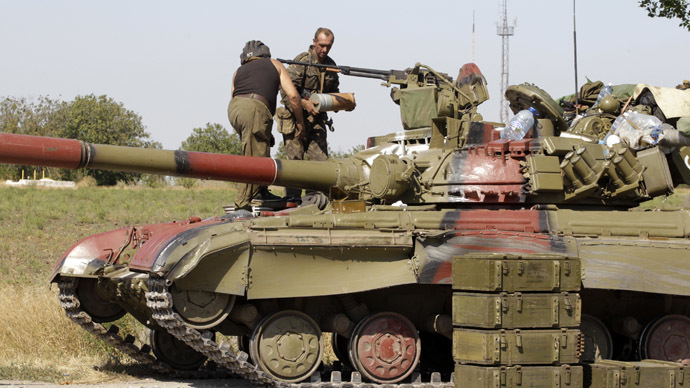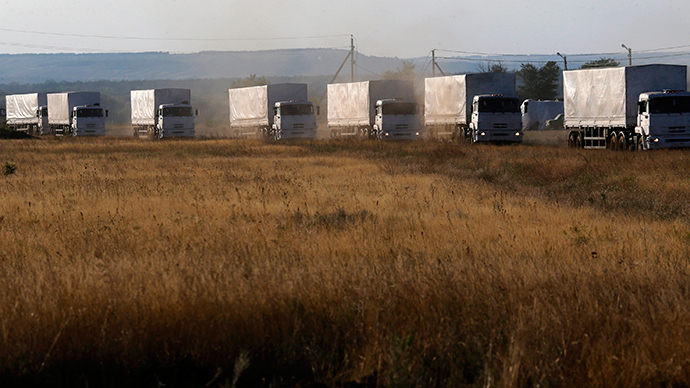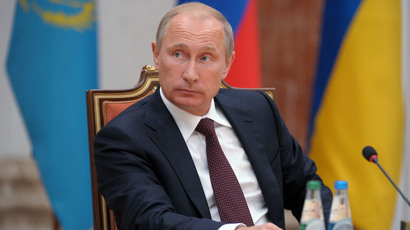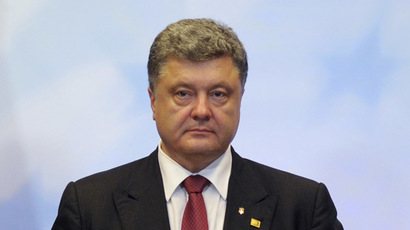Ukraine peace plan: Withdraw military hardware, exchange POWs, open corridors

Both sides in the Ukrainian conflict have agreed to “all to all” prisoners of war exchange, hardware withdrawal and humanitarian aid access to the area. Kiev and rebel troops laid down arms as the main agreement – ceasefire- came into force at 15:00 GMT.
READ MORE:Kiev, E. Ukraine militia agree on ceasefire starting 1500 GMT Friday
The contact group in Minsk agreed on three key issues: ceasefire,
exchange of war prisoners and humanitarian aid access, OSCE envoy
Tagliavini told reporters.
“We continued consultation and agreed on other issues. Among
them are the ceasefire, the withdrawal of troops and the "all to
all" exchange of prisoners,” she said.
MT @SwissOSCE2014: Swiss CiO Burkhalter welcomes Minsk agreement, assures Pres Poroshenko of @OSCE support http://t.co/gPK8OLSlsW#ukraine
— СММ ОБСЄ в Україні (@OSCE_SMM) September 5, 2014
Talking to reporters on the sidelines of the NATO summit in Wales, Ukrainian President Petro Poroshenko said that prisoner of war exchange can take place “soon, maybe tomorrow.”
According to estimates enumerated by Russia's ambassador to Ukraine, Mikhail Zurabov, the exchange may affect “more than 1,000 people from each side.”
“We exchanged lists of prisoners and started the exchange process immediately,” said former Ukrainian President Leonid Kuchma, who represented Ukraine at the talks in Minsk.
“Within three days an expert group will be formed, which should provide a thorough plan of the release of prisoners of war,” Zurabov said.
The expert group will have to work out all the technical details, including places of exchange.
Kiev and the rebels also agreed to provide humanitarian aid to devastated regions in southeastern Ukraine.
“The first humanitarian cargo in Donbass has to be delivered on Saturday. On Monday there will be a more or less thorough plan of humanitarian corridors developed for the future for anyone who wants to help Donetsk and Lugansk,” Kuchma said. “In the next ten-day period, the second convoy of humanitarian cargo will be delivered by train. Then all donors, who want to help Donbass, will be able to send humanitarian aid,” he added.

The two sides, however, abstained from discussing the main bone of contention, which is the status of Ukraine’s southeastern regions. The self-proclaimed Donetsk People’s Republic (DNR) and Lugansk People’s Republic (LNR) are seeking independence from Kiev and the creation of the state of Novorossiya (“New Russia”).
The question of the status of the two regions was not a priority, DNR Prime Minister Aleksandr Zakharchenko told reporters after the meeting.
"It's not so important. The most important thing now is to stop the bloodshed,” he said.
“We have not reached that point, we mainly talked about the ceasefire,” Igor Plotnitsky, Lugansk’s leader, said. "We had no assurance that we would be able to negotiate. But as a result of negotiations, we realized that on both sides of the conflict there are the people, we need to get people back to their homes," he added.
It has been decided that once the military conflict is settled, Kiev, Donetsk and Lugansk will have to return to the negotiations table to discuss Donbass region’s status again.
“However, the ceasefire does not mean a shift from our course of breaking away from Ukraine. This is a compulsory measure,” he said.

Both Kiev’s army and militia forces laid down arms at 15:00 GMT, as stipulated by the agreed 12-point protocol.
“According to the decision of the president of Ukraine and
the order of the chief of the General staff of the military units
of Ukraine, troops in the area of anti-terrorist operations
ceased fire at 15.00 GMT,” Lysenko said.
Rebel forces have also issued the same order.
“In the execution of the Minsk agreements, we stopped fighting at 18:00. This decision has been communicated to all departments,” RIA Novosti reported.
The ceasefire was welcomed by the OSCE, which had also been part of the closed-door meeting in Minsk.
The organization’s Heidi Tagliavini described the development as “good news.”
The UN Chief Ban Ki-moon has also welcomed the truce. He called for “credible, comprehensive monitoring and verification” of compliance with the bilateral ceasefire.
Earlier President Poroshenko called on both the Ukrainian Foreign Ministry and the OSCE to provide international monitoring of the process.
“We must do everything possible, and impossible, to stop bloodshed and put an end to people’s suffering,” the president said in a statement posted on his official website.














